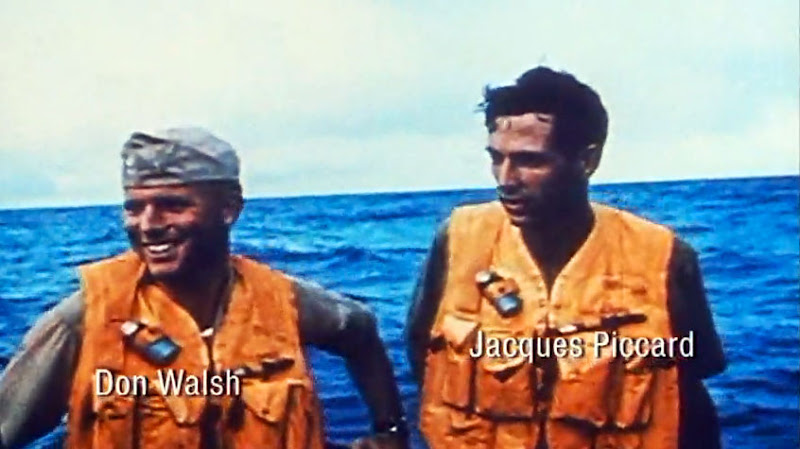James Cameron Leads Race Into Mariana Trench
Friendly Competition with Richard Branson

Director James Cameron is leading a race to the bottom of the Mariana Trench, the deepest part of the world’s oceans. Of the four teams vying for the achievement, Cameron’s is in the lead, and the descent would make him the third human to explore the deepest part of the trench, called Challenger Deep – more people have been on the moon than down Mariana, which is deeper than Mt. Everest is tall. In what has been dubbed a “race to inner-space,” Cameron might be in position to beat out Sir Richard Branson and his Virgin Oceanic Team, as the first aquanaut since 1960 to descend Challenger Deep.
Cameron, 57, the Oscar-winning director from Canada, is getting ready to make a dangerous solo descent into the near 36,000 ft deep trench, located in the Pacific Ocean, within weeks. Virgin’s Chris Welsh originally hoped to claim this record by the end of the year, but Cameron plans to curl his 6’1″ frame into a small submersible built to withstand 16,000 psi. This is roughly equal to 8,000 elephants standing on top of a Mini Cooper. It would seem that the director of The Abyss should rightly get first dibs.
US Navy Captain Don Walsh, one of the crew members who emerged from a voyage to Challenger Deep aboard the bathyscaphe Trieste in 1960, calls Cameron “Cousteau on steroids,” and gives him his blessing. Walsh adds, “Jim is a remarkable guy who’s never trained as an engineer but has an intuitive grasp of engineering details that far surpass a lot of the professionals I’ve known.”
Losing pressure in the passenger compartment of the sub would cause Cameron’s battery-powered vessel to implode. Even the smallest leak would allow a stream of water to rush in at such a pressure that the vessel would be ripped in half. Cameron told Popular Mechanics last year that “there have been white-knuckle moments, complete power failures where we’ve had to use emergency ballast systems to get back… Yeah, your life is at risk any time you go into a hostile environment like that – but you trust the engineering.”
A clip from Cameron’s The Abyss describes a loss of cabin pressure in the deep:
 http://www.youtube.com/watch?feature...&v=FkhBPF4yfkI
http://www.youtube.com/watch?feature...&v=FkhBPF4yfkI
Outwardly, Cameron and Branson’s Oceanic Team have exhibited competitiveness, along with the teams of Triton Sub and DOER, but all have assisted one another’s progress to the bottom. Eddie Kisfaludy, Virgin Oceanic’s operations manager, states, “of course there’s some desire behind each individual to be first but the nice thing about working with Cameron is that we get to share some of the technology together – though the media has portrayed it as a race, it’s also been a nice collaboration to share technologies and learn from each other.”
http://www.webpronews.com/james-came...trench-2012-03
The 1960 descent to the Challenger Deep is something everyone should know about. It's comparable to that thing we did 9 years later.
At a depth of nearly 11 km The Challenger Deep is the deepest point in the ocean. If you were to stick Everest down there, it'd still have 2 km of ocean above it.
Here's a nice graphic that gives some feeling of the depth:

In 1960 two men, Don Walsh and Jaque Piccard, clambered into a submarine named the Trieste. The Trieste had a small, pressurised, spherical chamber attached to its hull which allowed it to go DEEP:

Walsh and Piccard inside the sphere:

This type of chamber had previously allowed its inventor, Auguste Piccard (Jacques' dad), to float into the stratosphere attached to a balloon to measure cosmic rays, and now it was to be used to descend to the Challenger Deep. So they start their descent. As they got deeper the light faded to absolute black, the temperature dropped and eventually their communications to the ship on the surface failed. They were completely alone.
After about 4 hours there was a loud crack - not something you want to hear when you're around 10 km underwater. It turned out that the outer pane of lucite on their tiny porthole had broken under the immense pressure. Walsh and Piccard decided that there was a good chance that the porthole would fail completely on the way back to the surface and so they may as well continue to the sea floor. As the Trieste continued its descent they huddled together, freezing and I would suspect terrified that at any moment their porthole would pop and they'd be subjected to 8 tons per square inch of pressure. After 45 more minutes, the Trieste landed about 11km down on the floor of the Challenger Deep and after turning on the exterior lights, Walsh and Piccard observed a flatfish and jellyfish, proving that complex life could exist at the deepest part of the ocean.
